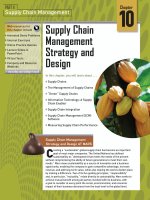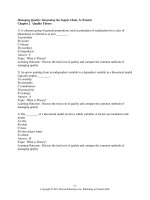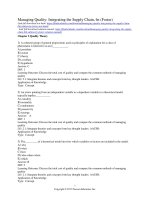Lecture Operations management: Creating value along the supply chain (Canadian edition) - Chapter 11
Bạn đang xem bản rút gọn của tài liệu. Xem và tải ngay bản đầy đủ của tài liệu tại đây (503.23 KB, 30 trang )
OPERATIONS MANAGEMENT:
Creating Value Along the Supply Chain,
Canadian Edition
Robert S. Russell, Bernard W. Taylor III, Ignacio Castillo, Navneet Vidyarthi
§
CHAPTER 11
Global Supply Chain
Procurement and Distribution
1
§
Learning Objectives
Procurement
E-Procurement
Distribution
Transportation
The Global Supply Chain
10-2
§
Procurement
The purchase of goods and services from
suppliers
Cross enterprise teams
coordinate processes between a company and
its supplier
On-demand (direct-response) delivery
requires the supplier to deliver goods when
demanded by the customer
Continuous replenishment
supplying orders in a short period of time
according to a predetermined schedule
10-3
§
Outsourcing
Sourcing
selection of suppliers
Outsourcing
purchase of goods and services from an outside supplier
Core competencies
what a company does best
Single sourcing
a company purchases goods and services from only a
few (or one) suppliers
10-4
§
Categories of Goods and Services
10-5
§
E-Procurement
Direct purchase from suppliers over the Internet,
by using software packages or through emarketplaces, e-hubs, and trading exchanges
Can streamline and speed up the purchase order
and transaction process
10-6
§
E-Procurement
What can companies buy over the Internet?
Manufacturing inputs
§
the raw materials and components that go directly into the
production process of the product
Operating inputs
§
maintenance, repair, and operation goods and services
10-7
§
E-Procurement
E-marketplaces (e-hubs)
Websites where companies and suppliers conduct
business-to-business activities
Reverse auction
process used by e-marketplaces for buyers to purchase
items; company posts orders on the internet for suppliers
to bid on
10-8
§
Distribution
Encompasses all channels, processes, and
functions, including warehousing and
transportation, that a product passes on its way to
final customer
Order fulfillment
process of ensuring on-time delivery of an order
Logistics
transportation and distribution of goods and services
Driving force today is speed
Particularly important for Internet dot-coms
10-9
§
Distribution Centers (DC)
and Warehousing
DCs are some of the largest business facilities in
the United States and Canada
Trend is for more frequent orders in smaller
quantities
Flow-through facilities and automated material
handling
Postponement
final assembly and product configuration may be done at
the DC
10-10
§
Warehouse Management Systems
Highly automated system that runs day-to-day
operations of a DC
Controls item putaway, picking, packing, and
shipping
Features
transportation management
order management
yard management
labor management
warehouse optimization
10-11
§
10-12
§
Vendor-Managed Inventory
Manufacturers generate orders, not distributors or
retailers
Stocking information is accessed using EDI
A first step towards supply chain collaboration
Increased speed, reduced errors, and improved
service
10-13
§
Collaborative Logistics and Distribution
Outsourcing
Graph or bar chart
Bars represent the time for each task
Bars also indicate status of tasks
Provides visual display of project schedule
Slack
amount of time an activity can be delayed without
delaying the project
10-14
§
Transportation
Rail
low-value, high-density, bulk products, raw materials,
intermodal containers
not as economical for small loads, slower, less flexible
than trucking
Trucking
main mode of freight transport in North America
small loads, point-to-point service, flexible
More reliable, less damage than rails; more expensive
than rails for long distance
10-15
§
Transportation
Air
most expensive and fastest, mode of freight transport
lightweight, small packages <500 lbs
high-value, perishable and critical goods
less theft
Package Delivery
small packages
fast and reliable
increased with e-Business
primary shipping mode for Internet companies
10-16
§
Transportation
Water
low-cost shipping mode
primary means of international shipping
inland waterways, canals, the Great Lakes, and along
coastlines
slowest shipping mode
Intermodal
combines several modes of shipping-truck, water and rail
key component is containers
Pipeline
transport oil and products in liquid form
high capital cost, economical use
long life and low operating cost
10-17
§
Internet Transportation Exchanges
Bring together shippers and carriers
Initial contact, negotiations, auctions
Examples
www.nte.com
www.freightquote.com
10-18
§
Global Supply Chain
International trade barriers have fallen
New trade agreements
To compete globally requires an effective supply
chain
Information technology is an “enabler” of global
trade
10-19
§
Obstacles to Global Chain Transactions
Increased documentation for invoices, cargo
insurance, letters of credit, ocean bills of lading or
air waybills, and inspections
Ever-changing regulations that vary from country
to country that govern the import and export of
goods
Trade groups, tariffs, duties, and landing costs
Limited shipping modes
Differences in communication technology and
availability
10-20
§
Obstacles to Global Chain Transactions
Different business practices as well as language
barriers
Government codes and reporting requirements
that vary from country to country
Numerous players, including forwarding agents,
custom house brokers, financial institutions,
insurance providers, multiple transportation
carriers, and government agencies
Since 9/11, numerous security regulations and
requirements
10-21
§
Duties and Tariffs
Proliferation of trade agreements
Nations form trading groups
no tariffs or duties within group
charge uniform tariffs to nonmembers
Member nations have a competitive advantage
within the group
Trade specialists
include freight forwarders, customs house brokers,
export packers, and export management and trading
companies
10-22
§
Duties and Tariffs
Landed Cost
Total cost of producing, storing, and transporting a
product to the site of consumption or another port
Value added tax (VAT)
an indirect tax assessed on the increase in value of a
good at any stage of production process from raw
material to final product
Clicker shock
occurs when an ordered is placed with a company that
does not have the capability to calculate landed cost
Web-based International Trade Logistic
Systems
International trade logistics web-based software
systems reduce obstacles to global trade
convert language and currency
provide information on tariffs, duties, and customs
processes
attach appropriate weights, measurements, and unit
prices to individual products ordered over the Web
incorporate transportation costs and conversion rates
calculate shipping costs online while a company enters
an order
track global shipments
10-25
§









